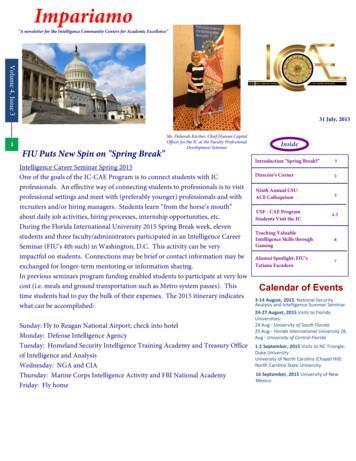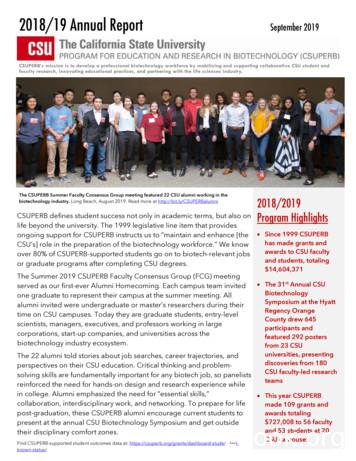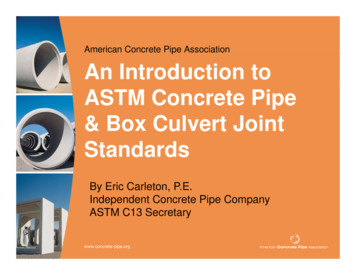CSU SEISMIC REQUIREMENTS - California State University
CSU SEISMIC REQUIREMENTSMarch 5, 2020http://www.calstate.edu/cpdc/ae
CSU Seismic Policy Quick Start Guide*Read this if you don’t read anything else*Scope: These CSU Seismic Requirements were established to implement the Seismic Policy set by theBoard of Trustees. The CSU Seismic Policy applies to all structures within the bounds of a CSU campusmaster plan. If a campus seeks to conduct operations at an off-campus location, the facility must beevaluated according to the ‘Standards for Acquiring Buildings and Space’ (Lease/Acquisition Policy).Project funding source has no effect on peer review need. CSU use is the determining factor. (Sec. 3.2,3.4, 8.0)Planning for all Capital Projects: Planning for all projects shall address the options considered to improveseismic performance beyond minimally required code conformance. The basis for determination of theselected option selected for shall be documented. (Sec. 7.0)What Needs Seismic Peer Review: All major capital building projects require peer review. All minorcapital building projects shall be seismically assessed; however, a Campus Deputy Building Official mayissue a written waiver for individual minor capital infrastructure and capital projects that do not havematerial seismic issues. In doubt, contact the campus peer reviewer to assess a project’s peer reviewneed. (Sec. 3.7, 4.0, 5.5)Early Notice to Design Team of Seismic Design Coefficients and Risk Category: The CSU hasestablished campus-specific ‘seismic ground motion parameters’ that supersede California Building(CBC) values and implements a conservative evaluation on CBC Structural Risk Category assignments. Asthese can have a substantial effect on project costs, it is imperative that campuses inform Contractorand Design team proposer of these CSU seismic requirements at the solicitation stage of a project. (Sec.3.1, 3.3)Peer Review: Peer review starts at project inception and continues until construction completion. Peerreview concurrence letters are issued at completion of the Schematic Preliminary Design andConstruction Documents Phases, and during the course of construction on deferred submittals that havea seismic component. (Sec. 4.0) All SRB peer review comments is required before start of construction,resolution of SRB construction phase submittals must be required prior to occupancy. (Sec. 3.8, 4.4, 5.18)When Required: Engage peer review concurrent with Project RFP development. Secure peer reviewconcurrence letters in advance of advertisement for proposals, CPDC schematic presentation and beforeconstruction begins. (Sec. 3.8, 4.2)Purchase, Lease: The CSU Seismic Requirements have standards for the purchase, lease, license andother form of acquisition or occupancy of buildings, or portions thereof. Compliance is required beforeactual occupancy begins. (Sec. 1.0, 8.0)Special Conditions: The CSU Seismic Requirements address many special conditions including:Geotechnical Investigations, Modular Buildings, Pre-engineered Structures, Temporary Use of Buildings,Voluntary Retrofits, Use of Engineered Wood Products, and Designated Seismic Systems. (Sec. 5.0)Change of Use: Temporary use changes ( 7 days) require a Special Event Permit. Coordinate with CDBO.Renovations that alter an existing CBC Use and Occupancy require CDBO and SRB review. Early conceptreview by SRB can readily provide an informal advisory assessment. (Sec. 5.20)CSU Seismic Priority Lists: Buildings on the CSU Priority Lists require seismic improvements be includedas a part of the project scope of any renovation work. (Sec. 7.0)CSU Seismic Emergency Response: In the event of a seismic or structural emergency contact any SRBpeer reviewer to assess the need for a mobilization response. If a mobilization response is warrantedCampus Deputy Building Official functions will be temporarily assumed by the SRB to rapidly assess whichbuildings are safe for use. (Sec. 6.0)Responsibility of Design Professionals During Construction: Design professionals are expected todirectly notify the CSU construction manager and seismic peer reviewer of potential constructionchanges or modification to the approved design documents that can substantively impact expectedstructural performance, and where appropriate directly contact the Seismic Peer Reviewer forconsideration of and concurrence with the changes as specific conditions warrant. (Sec. 3.10)i
Table of Contents1. CSU SEISMIC POLICY . 12. SEISMIC REVIEW BOARD . 23. CODES AND STANDARDS APPLICABLE TO CSU CONSTRUCTION ACTIVITY . 23.1 Minimum Requirements. 33.2 Application to New Buildings . 43.3 Campus Seismic Coefficients. 43.4 Application to Existing Buildings . 63.5 Code Enforcement . 73.6 Active Faults . 83.7 Peer Review for Small Projects . 93.8 Peer Review Verification . 103.9 Engineer-of-Records (EOR) . 103.10 Responsibility of Design Professionals during Construction . 103.11 Special Inspections . .114. PEER REVIEW . 114.1 Scope of Review . 124.2 Timing of Peer Review . 134.3 Reports . 134.4 Responses and Corrective Actions . 134.5 Distribution of Reports. 144.6 Design Professional Responsibilities . 144.7 Resolution of Differences. 144.8 Peer Review Contracts and Cost . 145. SPECIAL CONSIDERATION. 145.1 Private Building Constructed on CSU Land . 145.2 Geotechnical Investigations . 145.3 EOR References to Geotechnical Investigations . 155.4 Changes and Additions to Published SRB Requirements . 155.5 Projects Not Warranting Peer Review . 155.6 Demolition Projects. 165.7 Material Properties of Existing Building. 165.8 Design Build and CM at Risk Projects . 165.9 Special Moment Frame Structural Systems . 175.10 Post-tensioned Structural Elements . 175.11 Alternative Methods of Construction . 175.12 Use of Engineered Wood Products . 185.13 Deferred Approvals or Multiple Design Packages . 185.14 Pre-engineered Structure . 195.15 Designated Seismic Systems . 205.16 Parking Structure Risk Category Determination . 215.17 Phased and Voluntary Retrofit . 215.18 Final Approval . 215.19 Earthquake Soil Pressure . 215.20 Temporary Use of Building and Structures . 226. POST EARTHQUAKE REVIEWS . 23ii
7. PROJECT PLANNING . 247.1 Priority Lists . 247.2 Project Planning 258. SEISMIC SAFETY STANDARD FOR ACQUIRING BUILDING AND SPACE . 258.1 Types of Acquisitions . 26A. Acquire By Lease or License . 26B. Acquire By Purchase or Title Transfer . 268.2 Acceptable Evaluation Document . 27A. Waiver Letter . 27B. FEMA Evaluation Report. 27C. Certification of Applicable Code . 28D. Independent Review report . 28Attachment A . 30CALIFORNIA STATE UNIVERSITY SEISMIC REVIEW BOARD. 30Attachment BSeismic Coefficients for CSU Campus Locations . 31Table 1CSU Campus Seismic Ground Horizontal Response Spectra Parameters . 32Table 1 Notes . 40Attachment CCampus Assignments for Peer Review . 41Attachment DEarthquake Performance Levels for Existing Buildings . 42Attachment ETechnical Guidelines . 44Attachment FReferences. 47Attachment GDocument History . 48iii
CSU Seismic RequirementsOriginally Adopted December 8, 2000; revised March 5, 20201. CSU SEISMIC POLICYThe California State University (CSU) Board of Trustees adopted the following policy to apply toall CSU construction projects.RESOLVED, by the Trustees of the California State University, that thefollowing policy is adopted:It is the policy of the Trustees of the California State University that to themaximum extent feasible by present earthquake engineering practice toacquire, build, maintain, and rehabilitate buildings and other facilities thatprovide an acceptable level of earthquake safety for students, employees,and the public who occupy these buildings and other facilities at alllocations where University operations and activities occur. The standardfor new construction is that it meets the life safety and damageabilityobjectives of Title 24 provisions; the standard for existing construction isthat it provides reasonable life safety protection, consistent with that fortypical new buildings. The California State University shall cause to beperformed independent technical peer reviews of the seismic aspects of allconstruction projects from their design initiation, including both newconstruction and remodeling, for conformance to good seismic resistantpractices consistent with this policy. The feasibility of all constructionprojects shall include seismic safety implications and shall be determinedby weighing the practicality and cost of protective measures against theseverity and probability of injury resulting from seismic occurrences.[Approved by the Trustees of California State University at its May 18-19, 1993 meeting(RTCPBG 05-93-13).]This policy is the basis for CSU seismic actions. CSU undertook the assessment of the seismichazard posed by the University’s building stock at the direction of Governor Deukmejian in 1992with resources provided by the Legislature in 1993. Since then CSU has had a vigorous programof reducing the unacceptable seismic risk to acceptable levels.The CSU Seismic Requirements describe the CSU framework used to implement the Trustees’Seismic Policy. Key objectives and requirements are excerpted below. Additional backgroundinformation and direction to the related policy requirements are provided for each.1. To the maximum extent feasible by present earthquake engineeringpractice the goal is to acquire, build, maintain, and rehabilitate buildingsand other facilities that provide an acceptable level of earthquake safety.Discussion: Actions necessary to accomplish this goal were initiated in1992 for existing buildings and will continue until all CSU existingbuildings meet the seismic safety objective of the Trustees and all newconstruction meets this goal. Each year capital expenditures arerecommended until the unacceptable safety hazard buildings areseismically retrofitted or removed from service. The Seismic ReviewBoard (SRB) is responsible to the Chancellor for review of expectedCSU Seismic RequirementsMarch 5, 2020Page 1
seismic performance characteristics of all CSU buildings and advises theChancellor of actions necessary to achieve an acceptable level of seismicrisk for CSU buildings. The SRB is addressed in Section 2. Safe use ofbuildings subjected to possible earthquake damaged is addressed inSection 6. Other special issues are addressed in Section 5. Standards forthe acquisition and lease of buildings are given in Section 8.2. The standard for: New construction is that it meets the life safety and damageabilityobjectives of Title 24 provisions: Renovation construction is that it provides reasonable life safetyprotection, consistent with that for typical new buildings.Discussion: The California Building Code (CBC) provides constructionstandards for both new construction and renovation of existing buildings.The code has added provisions for existing buildings since the Trustees’policy was established. (The implementation of these standards isaddressed in Section 3)3. Independent technical peer reviews shall be conducted concerning theseismic aspects of all construction projects from their design initiation,including both new construction and remodeling, for conformance togood seismic resistant practice consistent with this policy.Discussion: The SRB is delegated responsibility to conduct independentpeer reviews of all CSU construction projects. Conduct of seismic peerreviews is addressed in Section 4.4. The feasibility of all construction projects shall include seismic safetyimplications and shall be determined by weighing practicality and cost ofprotective measures against the severity and probability of injuryresulting from seismic occurrences.Discussion: The CBC establishes minimum standards for building safety.Section 7 of the CSU Seismic Requirements addresses the incorporationof seismic design and review into facilities planning and campusdevelopment.2. SEISMIC REVIEW BOARDThe SRB was established in 1992. It is charged with implementing the independent peer reviewrequirements of the Trustees’ seismic policy. The Board also advises CSU on structural engineeringissues for specific projects. Membership is comprised of professionals not otherwise affiliatedwith the University system. Board members are appointed by, and serve at the discretion ofthe Chancellor. The Board membership is listed in Attachment A.3. CODES AND STANDARDS APPLICABLE TO CSU CONSTRUCTION ACTIVITYBy law, the California State University is required to enforce the current edition of the CBCas adopted by the California Building Standards Commission. To facilitate this legal requirementthe CSU has adopted, as policy, selected additional sections of Chapter 1 Scope andAdministration of the CBC related to code administration, code enforcement, and codeinterpretation. See State University Administrative Manual (SUAM) Section XI for listing ofCSU Seismic RequirementsMarch 5, 2020Page 2
sections adopted as policy. This Seismic Policy supplements the requirements of the CBC. Whererequirements differ the more restrictive shall apply.The Building Code applies to all construction activity undertaken by CSU and applies to bothseismic and non-seismic requirements for construction. The two sections address the seismicdesign of structures: the requirements for new buildings are found in Chapter 16 of Part 2volume 2 of the California Code of Regulations, known as the California Building Code (CBC); andthe requirements for existing retrofit/renovation and repair to
The CSU Seismic Requirements standards for the purchase, lease, license have and other form of acquisition or occupancy of buildings, or portions thereof. Compliance is required before actual occupancy begins . (Sec. 1.0, 8.0) Special Conditions: The CSU Seismic Requirements address many special conditions including:
Search Committee Member Login Page 3 1. If you are a current CSU employee, use the left side CSU User Login to access the Talent Management System. Once you have clicked the CSU User Login button, you will be taken to CSU's Authentication Required verification page where you will be asked to enter your CSU credentials (i.e. ename and CSU .
The CSU awards 36% of California's undergraduate nursing degrees. The CSU prepares more of California's teachers, pre-school through grade 12 than any other institution. Nearly four percent of the nation's teachers graduate from the CSU. In 2020, CSU students earned nearly 25,000 business degrees and more than 9,000 engineering degrees.
CSU East Bay CSU Fullerton CSU Long Beach CSU Los Angeles CSU Monterey Bay CSU Northridge . Student Majors Biology, Business Administration, Computer Science, Psychology, Political Science, Public Health . Impacted
universities including: CSU San Bernardino, CSU Fullerton, CSU Long Beach, CSU Northridge, CSU San Marcos, CSU Cal Poly Pomona, the University of Redlands, Azusa Pacific University, UC Riverside, Chaffey College, San Bernardino Valley College and Vic
Bakersfield (CSU) Channel Islands (CSU) * Northridge (CSU) San Bernardino (CSU) * San Luis Obispo (CalPoly) * * - no collection, however, CUS Chancellor's Office will need a formal letter of declaration. 1. st . CSU NAGPRA Coordinators Meeting . 2 . I. 8:00-8:45 a.m. Welcome and Roundtable Introductions .
Math Cuajungco CSU Fullerton Daryl Eggers San José State University Matthew Escobar CSU San Marcos Paula Fischhaber, Deputy Chair CSU Northridge Tomas Gomez-Arias, Dean CSU Stanislaus Michael Goldman San Francisco State University Katherine Kantardjieff, Dean CSU San Marcos Jennifer Lillig-Whiles Sonoma State University Monica Lounsbery, Dean
CALIFORNIA STATE UNIVERSITY AND UNIVERSITY OF CALIFORNIA LOCATIONS UNIVERSITY OF CALIFORNIA CAMPUSES . East Bay CSU, Fresno CSU, Fullerton CSU, Long Beach CSU, Los Angeles CA Maritime Academy . significantly higher if the campus or the major is impacted. 3. Com
ASTM C 1628 06ASTM C 1628 06 Standard Specification for Joints for Concrete Gravity Flow Sewer Pipe Using Rubber Gaskets AS C 16 09ASTM C 1677 09 Standard Specification for Joints for Concrete Box, Using Rubber Gaskets ASTM C 1619 05 Standard Specification for Elastomeric Seals for Joining Concrete Structures ASTM C 505 05a Standard Specification for Irrigation Pipe with Rubber Gasket Joints .























